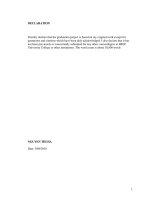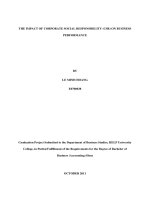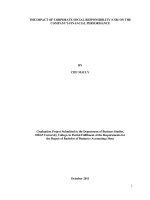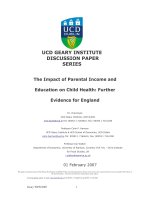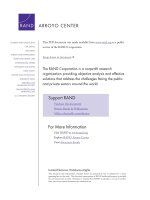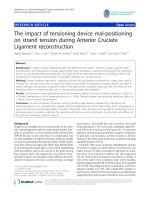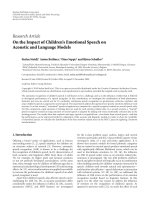wang - 2003 - the impact of mandatory audit firm rotation on auditor-client negotiations
Bạn đang xem bản rút gọn của tài liệu. Xem và tải ngay bản đầy đủ của tài liệu tại đây (3.62 MB, 85 trang )
THE IMPACT OF MANDATORY AUDIT FIRM ROTATION ON
AUDITOR-CLIENT NEGOTIATIONS
by
Jianqiang Wang
Bachelor of Arts
Fudan University, 1982
Master of Arts
Fudan University, 1986
Master of Accountancy
University of South Carolina, 1996
Submitted in Partial Fulfillment of the Requirements
for the Degree of Doctor of Philosophy in
Moore School of Business
University of South Carolina
2003
Director of Dissertation
Committee Member
Committee Member
fommittee Member
Dean of The Graduate School
Reproduced with permission of the copyright owner. Further reproduction prohibited without permission.
UMI Number: 3098716
UMI
UMI Microform 3098716
Copyright 2003 by ProQuest Information and Learning Company.
All rights reserved. This microform edition is protected against
unauthorized copying under Title 17, United States Code.
ProQuest Information and Learning Company
300 North Zeeb Road
P.O. Box 1346
Ann Arbor, Ml 48106-1346
Reproduced with permission of the copyright owner. Further reproduction prohibited without permission.
DEDICATION
I dedicate this dissertation to my beautiful wife, Min, who has amazingly made a
philosopher an accounting professor, and to our wonderful son, Diexia, who has easily
made a lousy accountant a great piano teacher by being one of the best young pianists in
America. Thank you for your support and making my life so enjoyable.
ii
Reproduced with permission of the copyright owner. Further reproduction prohibited without permission.
ACKNOWLEDGEMENTS
I would like to offer my sincere thanks to my dissertation chair, Dr. Brad Tuttle,
for being incredibly generous with his talent and time in helping me develop, conduct,
and finish this study. Without his remarkable and tireless effort, this work would not have
been possible. I also want to extend my special thanks to Dr. Maribeth Coller for giving
me so much help in so many ways since I took my first accounting course from her, to
Dr. Scott Jackson for always providing insightful and challenging feedback and
comments on my work, and to Dr. Lisa Rutstrom for her expert advice on experimental
economics and many other contributions to the completion of this dissertation. I was very
fortunate to have these wonderful scholars on my dissertation committee and I am deeply
grateful for their invaluable guidance and support throughout the whole process of
writing this dissertation.
I also would like to thank the School of Accounting faculty, especially Dr. Rich
White, Dr. Adrian Harrell, Dr. Scott Vandervelde, Dr. Tim Doupnik, Dr. Gene
Chewning, and Dr. A1 Leitch, for helping me in various stages of this work and in many
years of my study in this great school. My gratitude and appreciation also go to Dr. Mark
Taylor and Dr. Todd DeZoort for their advice and encouragement before and after they
left this school.
It is my great pleasure to acknowledge the friendship and support of my fellow
Ph.D. students: Young-Won Her, Jennifer Kahle, George Tsakumis, and Danny Wadden.
It has been four unforgettable years and we had so much fun.
I also want to acknowledge financial support for this study from the Moore
School of Business.
iii
Reproduced with permission of the copyright owner. Further reproduction prohibited without permission.
ABSTRACT
Mandatory rotation of audit firms has become an increasingly attractive
regulatory option to lawmakers in light of a series of recent disastrous corporate
accounting scandals. The Sarbanes-Oxley Act of 2002 requires a study of potential
effects of such a regulation.
This study investigates how the mandatory rotation of audit firms will affect
auditor-client negotiations when there is a disagreement on accounting values to report in
financial statements. It is hypothesized that the imposition of mandatory rotation will
reduce the auditor's incentive to compromise throughout the entire term of the audit
engagement with a client and will also reduce the client's incentive to compromise in the
final engagement year. As a result of such changes in the auditor’s and the client’s
incentives to compromise, any regulation that requires mandatory rotation of audit firms
may have unanticipated effects on the outcome of auditor-client negotiations, i.e., the
financial statements issued to the public.
The study was conducted through experiments in a laboratory setting in which
participants assumed the role of a manager (client) or of a verifier (auditor). Using a
computerized negotiation system, participants negotiated an asset value to report under
one of two manipulated conditions—limited auditor term (i.e., mandatory audit firm
rotation) or unlimited auditor term. The effects of mandatory rotation are measured by the
rate of agreement between auditors and clients and the agreed-upon asset values. It is
found that mandatory rotation results in a lower rate of agreement between auditors and
clients and lower agreed-upon asset values.
iv
Reproduced with permission of the copyright owner. Further reproduction prohibited without permission.
TABLE OF CONTENTS
Chapter 1: INTRODUCTION
Chapter 2: THEORY AND HYPOTHESES
2.1 Auditor-Client Disagreements
2.2 Incentives Facing the Client
2.3 Incentives Facing the Auditor
2.4 Hypotheses
Chapter 3: METHOD
3.1 Experimental Task
3.2 Experiment Design
3.3 Independent Variables
3.4 Dependent Variables
3.5 Negotiation Procedure and Rules
3.6 Payoffs
3.7 Participants
Chapter 4: RESULTS
4.1 Randomization and Manipulation Check
4.2 Descriptive Statistics
4.3 Hypothesis Tests
4.4 Other Tests
Chapter 5: CONCLUSION
REFERENCES
APPENDIX
1
6
6
8
11
14
19
19
22
22
24
24
27
31
33
33
34
41
52
54
59
66
Reproduced with permission of the copyright owner. Further reproduction prohibited without permission.
LIST OF TABLES
Table 3.1: Participant Demographics 32
Table 4.1: Analysis of Variance of Continuous Demographic Data 34
Table 4.2: Descriptive Statistics: Mandatory Rotation Condition 35-36
Table 4.3: Descriptive Statistics: Mandatory Rotation Condition
(Non-Final periods) 37-38
Table 4.4: Descriptive Statistics: Mandatory Rotation Condition
(Final periods) 39-40
Table 4.5: Descriptive Statistics: No Mandatory Rotation Condition 41
Table 4.6: Rate of Agreement: Comparison between Mandatory Rotation
Condition and No Mandatory Rotation Condition 42
Table 4.7: Rate of Agreement: Comparison between Mandatory Rotation
Condition (Non-Final periods) and No Mandatory Rotation
Condition 42
Table 4.8: Rate of Agreement: Comparison between Mandatory Rotation
Condition (Final Periods) and No Mandatory Rotation Condition 43
Table 4.9: Rate of Agreement: Comparison between Non-Final Periods and
Final Periods within Mandatory Rotation Condition 44
Table 4.10: Correlation between Auditor Tenure and Asset Values within No
Mandatory Rotation Condition: All Negotiation Resulting in Agreement 45
Table 4.11: Correlation between Auditor Tenure and Asset Values within No
Mandatory Rotation: Negotiations lasting Longer than Eight Periods 46
Table 4.12: Asset Values: Comparison between Earlier Periods and Later Periods
within No Mandatory Rotation Condition 47
Table 4.13: Asset Values by Negotiating Pair: Comparison between Mandatory
Rotation Condition and No Mandatory Rotation Condition 48
Table 4.14: Asset Values by Verifier or Manager: Comparisons between Mandatory
Rotation and No Mandatory Rotation 49
vi
Reproduced with permission of the copyright owner. Further reproduction prohibited without permission.
Table 4.15: Asset Values by Negotiating Pair: Comparison between Mandatory
Rotation Condition (Non-Final Periods) and N o Mandatory Rotation
Condition 50
Table 4.16: Asset Values by Negotiating Pair: Comparison between Mandatory
Rotation Condition (Final Periods) and No Mandatory Rotation
Condition 50
Table 4.17: Asset Values by Negotiating Pair: Comparison between Non-Final
Periods and Final Periods within Mandatory Rotation Condition 51
Table 4.18: Tests of Behavior Over Time: Rate of Agreement 52
Table 4.19: Tests of Behavior Over Time: Asset Values 53
vii
Reproduced with permission of the copyright owner. Further reproduction prohibited without permission.
LIST OF FIGURES
Figure 3.1: Asset Values Distribution 20
Figure 3.2: Experiment Design 22
Figure 3.3: Payoffs 28-29
viii
Reproduced with permission of the copyright owner. Further reproduction prohibited without permission.
“The Comptroller General of the United States shall conduct a study and review of the
potential effects of requiring the mandatory rotation of registered public accounting
firms.”
—Sarbanes-Oxley Act o f2002, H. R. 3763-31
“All of the technical aspects [of auditing] are important but they can’t substitute for the
primary skill, which is the art of negotiation.”
—Michael Buxbaum
The CPA journal, 72(5), p.80, May 2002
1. INTRODUCTION
Auditors and clients may not always agree on accounting principles or practices,
financial disclosure, or auditing scope or procedures. Auditor-client disagreements often
occur because the auditor and client have different preferences representing legitimate
but divergent beliefs regarding the appropriate application of the current
accounting/auditing standards (Magee and Tseng 1990; Dye 1991; Antle and Nalebuff
1991; DeAngelo et al. 1994; Defond and Subramanyam 1998). In these circumstances,
auditors and clients often attempt to resolve their disagreements through a process that
resembles negotiation (Murnighan and Bazerman 1990; Antle and Nalebuff 1991; Dye
1991; Zhang 1999; Gibbins et al. 2001).
Prior research suggests that costs associated with an auditor switch should
influence auditor-client negotiations (Magee and Tseng 1990; Dye 1991; Antle and
Nalebuff, 1991; Teoh 1992; Zhang 1999). From the auditor’s perspective, there are at
least two types of switching costs: (1) inefficiencies arising from learning to audit a new
client and (2) the loss of potential revenue before the lost client is replaced. The second
1
Reproduced with permission of the copyright owner. Further reproduction prohibited without permission.
type of switching costs to the auditor relates to auditor tenure more directly than does the
first type of switching costs to the auditor. It is easy to see that the magnitude of
switching costs to the auditor resulting from losing the client is determined by, among
other factors, the size of the client revenue, the duration of the engagement relationship,
and the auditor’s ability to find a replacement client. Like the auditor, the client also
bears at least two types of switching costs: (1) inefficiencies arising from having to deal
with a new auditor and (2) possible negative reactions to the auditor switch from
outsiders who have unfavorable perceptions as to the cause of the switch. The second
type of switching costs to the client also relates to auditor tenure more directly than does
the first type of switching costs to the client. It is easy to see that a short-lived
relationship appears to be more problematic than a relationship that lasts for as long as
most other relationships. An example of this type of switching costs to the client is that
outsiders may perceive an auditor switch to be motivated by opining shopping and
respond negatively to the client. That is, when outsiders have such a negative perception
of the auditor switch, the client will likely suffer substantial costs imposed by investors,
lenders, and regulators. These costs are, in effect, “political” costs. The purpose of this
study is to investigate the potential effects of mandatory audit firm rotation (hereafter
mandatory rotation) on auditor-client negotiations through its impact on the two
particular types of switching costs: switching costs to the auditor resulting from lost
revenue until the client is replaced and switching costs to the client resulting from
outsiders’ negative perception of an auditor switch, or the political switching costs.
Mandatory rotation has been proposed over decades as a regulatory mechanism to
reduce the influence that clients are assumed to exert on their auditors (e.g., U.S. Senate
2
Reproduced with permission of the copyright owner. Further reproduction prohibited without permission.
1976, 1977; AICPA 1978; Berton 1991; SEC 1994a; Wolf et al. 1999; Benson, 2002;
Imhoff 2003). In response to the recent audit failures with some of the largest U.S.
corporations, several bills have been proposed in the House and Senate that contain
provisions limiting the term of the auditor-client relationship as part of an effort to
improve financial reporting and protect investors.1 The Sarbanes-Oxley Act of 2002 that
recently has been signed into law calls for a study and review of the potential effects of
mandatory rotation, due July 2003, in contemplation of possible Congressional action on
this measure (Sec. 207 (a), H.R. 3763-31).
Mandatory audit-firm rotation may accomplish some of its intended goals, but
there may also be other consequences that have not been sufficiently explored. Prior
studies argue that because auditor switching will occur more frequently, mandatory
rotation will dramatically increase switching costs borne by both the auditor and the
c
lient and result in a decline in audit quality (Elitzur and Falk 1996; Arrunada and Paz-
Ares 1997; Comunale and Sexton 2002). Prior studies also argue that because each client
can be retained only for a limited number of years, mandatory rotation will dramatically
reduce the incumbency value of each client to the auditor and therefore enhance auditor
independence (Imhoff 2003; Gietmann and Sen 2002; Dopuch et al. 2001; Brody and
Moscove 1998; Petty and Cuganesan 1996; Wallman 1996; Copley and Doucet 1993).
All of these studies, while focusing on different aspects of an audit engagement and
making different cost/benefit analyses, share the same view that switching costs will go
up with the imposition of mandatory rotation. No study has addressed the possibility that
The “Integrity in Auditing Act o f 2002” bill suggests that auditors should not be considered independent
if they have audited a firm for more than seven years. The “Comprehensive Investor Protection Act o f
2002” suggests that non-independence is a problem when the auditor has consecutively audited a firm’s
financial statements for more than four years. The “Truth and Accountability in Accounting Act o f 2002”
states that an auditor should not be considered independent if it has audited a firm’s financial statements for
more than seven consecutive years.
3
Reproduced with permission of the copyright owner. Further reproduction prohibited without permission.
because periodic switching is required, mandatory rotation will eliminate, for these
required switches, the switching costs associated with outsiders’ possible negative
perceptions of an auditor switch, or the political switching costs. Furthermore, no study
has addressed the possibility that because the ability of the auditor to replace a lost client
will increase dramatically as a result of more clients looking for new auditors, mandatory
rotation will reduce the switching costs associated with the auditor’s loss of the client
revenue. Because mandatory rotation will likely alter switching costs to both the client
and the auditor, it is important to investigate how such changes may influence auditor-
client negotiations.
The research question of this study is investigated using laboratory negotiation
methods. This type of experimental method, which has been used in other areas of
accounting research such as transfer pricing, budgeting, and labor-management
negotiations, has the potential to provide unique insights into the process of financial
statement preparation that is otherwise unobservable. Experiment participants assumed
the role of a manager (client) or of a verifier (auditor) in a negotiation where they tried to
resolve their disagreements over an asset value. The client had an incentive to report a
higher asset value, while the auditor had an incentive to report a lower asset value. Half
of the negotiating pairs negotiated without restriction on auditor tenure whereas the other
half had auditor term limits imposed. The outcomes of the negotiations were measured by
the rate of agreement and the agreed-upon asset values.
The remainder of this dissertation is organized as follows. Chapter 2 provides a
review of the related literature and develops the hypotheses. Chapter 3 describes the
4
Reproduced with permission of the copyright owner. Further reproduction prohibited without permission.
research method. Chapter 4 presents proposed analyses. Chapter 5 concludes the paper
with a discussion of the implications and limitations of the study.
5
Reproduced with permission of the copyright owner. Further reproduction prohibited without permission.
2. THEORY AND HYPOTHESES
This chapter first defines the term “auditor-client disagreement” as used in this
study. It then discusses the differing incentives facing the client and the auditor that drive
auditor-client negotiations and develops hypotheses comparing the outcomes of auditor-
client negotiations in the presence and absence of mandatory rotation.
2.1 Auditor-Client Disagreements
The term “auditor-client disagreement” as used in this study refers to any situation
in which the auditor and the client have different preferences with respect to the financial
statements. The term thus has a broader meaning in this study than in the frequently cited
SEC definition that focuses only on reportable disagreements—disagreements that, if not
resolved to the auditor’s satisfaction, would have caused reference in the auditor’s report
(SEC 1974b). Reportable disagreements occur when “an authorized representative of the
client persists in a position and the audit partner in charge of the engagement reaches an
unequivocal contrary position as to a material matter” (SEC 1974b). Clearly, the auditor
can reach an unequivocal position only when the professional standards provide
unequivocal solutions. The SEC’s definition does not address disagreements where the
professional standards are ambiguous and both the auditor and the client’s positions are
defensible within these standards (Kay 1976). For example, the auditor may disagree with
“managers’ subjective estimates that cannot, by definition, be objectively verified by
auditors prior to occurrence” (Francis and Krishnan 1999, 135).
6
Reproduced with permission of the copyright owner. Further reproduction prohibited without permission.
Magee and Tseng (1990) argue that a dismissal threat from the client, when the
auditor disagrees with the client’s position on a reporting issue, is credible only if
auditors in the market disagree among themselves over the same issue. They further
argue that auditors in the market differ in their opinions on an accounting or auditing
issue only if the current professional standards allow them to do so. These arguments
explain why auditor-client disagreements that arise in the area where the professional
standards are ambiguous and vague are particularly worth investigating. As the SEC
(2001, 16) states in its recent ruling on auditor independence:
It is rarely the black-and-white issues that an auditor faces. The danger lies
in the gray area—where the pressure to bend to client interest is subtle, but
no less deleterious.
From an economic perspective, auditor-client disagreements occur because each
party faces different incentives. That is, the possibility for disagreements to exist within
the current professional standards is not a sufficient condition for disagreements to occur.
Rather, the current professional standards are used to legitimize disagreements that are
driven by conflicting incentives. If both parties have similar incentives, one would
expect them to agree. Only when the auditor and client face different incentives does one
expect them to disagree. Taking such an economic perspective, the SEC (2001) suggests
that when deliberating the need for accounting regulations, legislators are not supposed to
expect anyone, including both auditors and clients, to behave in one way when there is an
incentive for him or her to behave in another way.
7
Reproduced with permission of the copyright owner. Further reproduction prohibited without permission.
2.2 Incentives Facing the Client
Executives and managers of public companies face pressure to report earnings
that meet financial analysts’ forecasts, that do not violate requirements of debt covenants,
and that maximize the value of management compensation plans or meet some other
needs that are tied with their personal welfare. These incentives produce a desire for
higher earnings and/or higher asset values in many cases (Beneish 1999; Coakley and
Loebbeck 1985; Hylas and Ashton 1982), although in some cases lower earnings could
be preferred (Barta and McKinnon 2003; DeAngelo et al. 1994; Antle and Nalebuff
1990). Because of auditors’ risk structure and the fact that higher earnings or asset values
increase auditor legal liability (Lys and Watts 1994), it is assumed that auditors are more
likely to disagree with a client who proposes higher rather than lower earnings or asset
values. Client incentives in this study are to increase asset values and are consistent with
several prior studies (e.g., Tuttle et al. 2002; Bell et al. 1998; Kinney and Martin, 1994).
Switching costs become part of the client’s incentive to negotiate with the auditor
when auditor-client disagreements occur. If the disagreement is not resolved to the
auditor’s satisfaction, the auditor may choose to issue a qualified opinion. To respond, the
client may consider switching auditors. A significant body of research suggests that
auditor-client disagreements and qualified opinions can result in auditor switches (e.g.,
Fried and Schiff 1981; McConnell 1984; Sarhan et al. 1991; Dhaliwal et al.1993;
Whisenant and Sankaragurusamy 2000; Chow and Rice 1982; Craswell 1988; Citron and
Tafflet 1992; Krishnan 1994; Krishnan and Stephens 1995; Krishan et al. 1996).
Prior studies attempt to explore, analytically, how switching costs affect the
client’s position in auditor-client negotiation (e.g., Magee and Tseng 1990; Dye 1991;
8
Reproduced with permission of the copyright owner. Further reproduction prohibited without permission.
Teoh 1992; Antle and Nalebuff 1991). It has been argued that the client’s decision on
whether to switch auditors is made after weighing the potential benefits against the
potential costs of an auditor switch. The client knows that auditors differ in their
approaches to risk and that potential successor auditors may be willing to adopt a less
conservative stance than is the current auditor willing to. This possibility, however, must
be balanced against likely switching costs to the client. If the client is convinced that it is
worth taking the risk to switch to a new auditor, opinion-shopping may occur. 2 On the
other hand, if the client believes that it is not economically wise to switch auditors at this
time, the client will be more willing to cooperate with the auditor in order to avoid an
auditor switch.
There are at least two types of switching costs facing the client. One is efficiency-
related transaction costs related to finding and working with a new auditor. The other is
costs associated with outsiders’ possible negative perception of the cause of an auditor
switch, i.e., the political switching costs. The latter type of switching costs exists because
auditor switches can signal auditor-client disagreements (Schwartz and Menon 1985;
Chow and Rice 1982; Fried and Schiff 1981; Dhaliwal et al. 1993). Even though only a
relatively small portion of auditor switches were actually caused by auditor-client
disagreements (Whisenant and Sankaraguruswamy 2002), voluntary auditor switches
invite outsiders’ suspicions that are likely to be unfavorable to the client. Because
outsiders may not be able to verify the true cause of an auditor switch, suspicions exist
regardless of what actually have caused the auditor switch. As long as an auditor switch
2 The SEC’s disclosure requirements for auditor switch may not be an effective deterrent to opinion-
shopping since these requirements have been often circumvented (Smith and Nichols 1982; Schwartz and
Soo 1996; Knapp, M. C., andF. Elikai 1988; Stevens 1991).
9
Reproduced with permission of the copyright owner. Further reproduction prohibited without permission.
is made voluntarily, i.e., not required by law, it is always possible that outsiders will
perceive an auditor switch as motivated by opinion-shopping.
The political switching costs addressed in this study should not be confused with
the concept of political cost discussed in Watts and Zimmerman’s (1986) Positive
Accounting Theory. Although large public companies tend to incur high political
switching costs, firm size is not the primary determinant of the political switching costs.
Small companies, like large companies, face possible political switching costs imposed
by their creditors and others who often closely monitor the organizations in which they
have interests. Creditors of small companies, in particular, are expected to be very aware
of auditor-client relationship because small companies tend to be financially less stable.
The political switching costs are important because they create a constraint on
client management behavior. That is, the existence of substantial political switching costs
can exert a great pressure on client management to accept their auditors’ position. The
constraint of the political switching costs on client management’s behavior can be
significant not only because such costs can be great, but also because they can be
imposed by the auditor. When audits are based on single-period contracts, as modern-day
audits typically are, not only can the client choose to dismiss an auditor, but also the
auditor can choose to resign from or not to renew the engagement and thus impose
switching costs on the client (Krishnan and Krishnan 1997; MacDonald 1997). DeFond et
al. (1992) and Wells and Loudder (1997) investigate the market reaction to auditor
resignation announcements and document negative stock price reactions to such
announcements, providing evidence that auditor resignation can effectively impose a
political cost on uncooperative clients. The auditor’s ability to impose the political
10
Reproduced with permission of the copyright owner. Further reproduction prohibited without permission.
switching costs on the client thus becomes an important part of the client’s incentive to
negotiate with the auditor, particularly when such costs are significantly greater than the
potential benefits of an auditor switch.
It is hypothesized that mandatory rotation will change the client’s incentive to
negotiate with the auditor in different engagement years in different ways. The political
switching costs will continue to exist when an auditor-client disagreement occurs at the
final stage of the audit in years prior to the final engagement year. Auditor switches
before the term is up are still voluntary and potentially signal negative information about
the auditor-client relationship. As a result, the client will continue to have an incentive to
cooperate with the auditor. However, the political switching costs to the client will
completely disappear if a disagreement regarding audited financial statements occurs in
the final engagement year. Because the client is mandated to switch to a new auditor in
the following year, the auditor switch that follows the current engagement cannot be a
negative signal about the client. Consequently, the client’s incentive to compromise will
be substantially lower when a disagreement occurs in the final engagement year than in
any previous years.
2.3 Incentives Facing the Auditor
The auditor also incurs switching costs, including efficiency-related costs of
learning to audit a new client and costs associated with acquiring a new client, as well as
the loss of revenue until the lost client is replaced. Like the client, in determining whether
to compromise in the event of an auditor-client disagreement, the auditor weighs
potential costs of an auditor switch against the potential benefits such as eliminating the
11
Reproduced with permission of the copyright owner. Further reproduction prohibited without permission.
litigation risk (Moore and Scott 1989; Magee and Tseng 1990; Teoh 1992; Dye 1993;
Krishnan and Krishnan 1997; Lee and Gu 1998). Evidence shows that auditors are less
willing to accommodate income-increasing accounting methods used by clients
experiencing poor or deteriorating financial performance because the litigation risk with
such clients is high (Dhaliwal et al. 1993; Pourciau 1993; Defond and Jiambalvo 1993;
Defond and Subramnayam 1998; Lys and Watts 1994; Francis and Krishnan 1999).
However, when the estimated cost of losing the client is greater than the potential benefit
of being uncompromising, auditors have an incentive to compromise (Magee and Tseng
1990; Antle and Nalebuff 1991; Raghunathan et al. 1994; Lee and Gu 1998, Zhang 1999;
Schatzberg and Sevcik 1994; Schatzberg et al. 1996; Calegari et al.1998).
The costs of losing a client in terms of lost revenue are determined by, among
other factors, the expected length of the relationship with the client and the auditor’s
ability to replace the client. Under the current institution, where auditor tenure is
unlimited and auditor-client relationships tend to last for many years, the pool of
replacement clients is quite small. Beck (1988) et al. show that the average auditor tenure
with publicly-traded companies in their sample is about 15 years with 74% of the
sampled auditor tenures being 17 years or more. Auditor-client relationships are even
longer with larger companies (Monti-Belkaoui and Belkaoui 1991). If the average auditor
tenure is 15-17 years, then only about 6% of all clients are in the market for an auditor in
any given year. Hence, when a client switches auditors, the previous auditor may be
unable to replace the lost client for a lengthy period of time. Particularly at the office
level of large audit firms where auditor-client negotiations take place, the probability of
immediately replacing a lost client is low. The partner doing the negotiations with the
12
Reproduced with permission of the copyright owner. Further reproduction prohibited without permission.
client faces an immediate threat of losing revenue, even though the overall portfolio of
clients at firm level may be not substantially affected.
It is hypothesized that mandatory rotation, if implemented, will force a significant
portion of clients into the market for a new auditor every year and thus substantially
increase the auditor’s prospects of replacing a client who voluntarily switches auditors.
That is, by changing certain structure of the audit market, mandatory rotation will
substantially reduce the potential cost of losing a client and thereby reduce the auditor’s
incentive to compromise when negotiating with the client. For example, adopting a four-
year mandatory rotation policy would put at least 25% of all clients in the market for an
auditor every year. Thus, even at the office level of audit firms, the probability of
replacing a client would increase relative to current levels. Mandatory rotation is thus
predicted to reduce the auditor’s incentive to compromise and consequently result in
relatively fewer agreements reached in auditor-client negotiations.
In the final engagement year, lost revenues from the client do not differ whether
the auditor chooses to compromise or not. Differential cost analysis holds that costs that
do not differ between two alternatives are irrelevant to decisions (Garrison and Noreen
2003; Jiambalvo 2001). Thus, loss of potential revenues is irrelevant to the auditor’s
decision during the negotiation with the client in the final engagement year since the
client is no longer legally retainable regardless of the auditor’s actions. Consequently, the
auditor has even less incentive to compromise in the final engagement year relative to
prior years under the condition of mandatory rotation. Because the auditor’s incentive to
compromise is further reduced in the final engagement year, mandatory rotation will
13
Reproduced with permission of the copyright owner. Further reproduction prohibited without permission.
likely produce fewer agreements, i.e., a lower rate of agreement, in the final engagement
year relative to years leading up to the final year.3
2.4 Hypotheses
To summarize the preceding discussions, mandatory rotation will change both the
auditor’s and the client’s incentives to compromise in the following ways. First, in years
before the final engagement year, mandatory rotation will not reduce the client’s
incentive to compromise because the political switching costs continue to exist. On the
other hand, mandatory rotation will reduce the
auditor’s incentive to compromise in these
years because the auditor is more likely to be able to replace a lost client. Hence, a lower
rate of agreement can be expected in these years compared to the rate of agreement under
the current institution without mandatory rotation. Second, in the final engagement year,
auditors’ incentive to compromise is further reduced because lost revenues are no longer
a consideration and at the same time, the client’s incentive to compromise is also
substantially reduced because the political switching costs are eliminated. Hence, it is
predicted that the rate of agreement will be lower in the final engagement year than in
prior years within the condition of mandatory rotation. These arguments lead to H I:
H I: Mandatory rotation will result in a lower rate of agreement between auditors
and clients.
If an agreement is reached in the negotiation, the outcome of the agreement, i.e.,
whether the disagreement is resolved in the client’s or in the auditor’s favor, is another
3 Some researchers argue that trying to establish a desirable reputation could either “harden” the auditor’s
position during the final engagement if independence is concerned (Chi et al. 2002), or “soften” the
auditor’s position if a perception o f hostility to the client is concerned (Comunale and Sexton 2002). Others
argue that mandatory auditor rotation does not allow the auditor to develop a reputation (Gietzmann and
Sen 2002). Examining the effects o f these factors is beyond the scope o f this study.
14
Reproduced with permission of the copyright owner. Further reproduction prohibited without permission.
important issue that needs to be investigated separately. The quality of financial
reporting, or financial statement values reported to the public, has been the primary
concern leading to the increasing volume of calls for mandatory rotation. One of the
assumptions held by many proponents of mandatory rotation is that there is a tendency
for auditors, over time, to gradually align with the wishes of their clients. For example,
the Metcalf Committee report (U.S. Senate 1976, 21) asserts that:
Long association between a corporation and an accounting firm may lead
to such close identification of the accounting firm with the interests of its
client’s management that truly independent action by the accounting firm
becomes difficult. One alternative is mandatory change of accountants
after a given period of years
However, research has found little evidence suggesting a negative correlation
between auditor independence and auditor tenure. To the contrary, evidence suggests that
the auditor is more willing to compromise in earlier years than in later years (Geiger and
Raghunandan 2002; Myers et al. 2002). These studies raise questions about whether
mandatory rotation will be effective in making auditors less willing to go along with their
clients. Because the effects of auditor tenure on auditor independence have not been
investigated using experimental methods, i.e., in a setting where the complex
confounding effects that archival studies found difficult to deal with can be effectively
controlled for, these findings may not be conclusive. Assuming auditors are conservative
so that they prefer reporting lower earnings and lower asset values in audited financial
statements, disagreements occur when clients prefer reporting higher earnings and higher
asset values. If the extended auditor tenure indeed gradually erodes auditor independence,
then the final reported agreed-upon asset values should gradually increase as the auditor
15
Reproduced with permission of the copyright owner. Further reproduction prohibited without permission.
tenure extends. To test this lay notion of the relationship between auditor tenure and
auditor independence, the following hypothesis is proposed:
H2: In the absence of mandatory rotation, agreed-upon asset values will be
higher in later engagement years than in early engagement years.
The existing negotiation literature generally does not provide a satisfactory theory
that can be used to predict agreed-upon asset values resulting from auditor-client
negotiations. Auditor-client negotiations are rather unstructured in nature and the
information setting of auditor-client negotiations, such as the payoffs to the auditor and
the client, are rather unique (Zhang 1999). Generally, it is difficult to generate complete
equilibrium predictions about unstructured negotiation outcomes using the tools of
standard noncooperative game theory because “the rich message-space and the real-time
nature of unstructured negotiation create an unmanageably large set of strategies” (Davis
and Holt 1993, 244). The alternative cooperative game theory, which introduces a social
perspective into economic analysis, deals with issues that are outside the scope of this
study. Thus, predictions about differences in agreed-upon asset values are based on the
same type of reasoning as predictions about the likelihood of agreement used to support
HI. That is, these predictions are based on an economic analysis of qualitative
differences in the auditor’s and the client’s incentives to compromise under the two
specific conditions, rather than on any existing game-theoretic model.
As suggested in discussions related to HI, mandatory rotation changes more than
the length of auditor-client relationship. It changes the nature of this relationship. That is,
imposing limits on auditor tenure will result not only in shortened auditor-client
relationships, but also in fundamental changes in both the auditor’s and the client’s
incentives to compromise. Specifically, auditors will have less incentive to compromise
16
Reproduced with permission of the copyright owner. Further reproduction prohibited without permission.
